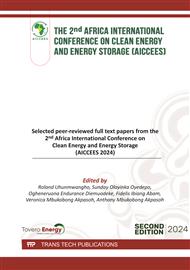p.3
p.19
p.33
p.43
p.53
p.65
p.85
p.121
Design and Analysis of a Supercritical Metal-Water Reactor for Hydrogen Gas Production
Abstract:
In this study, a supercritical metal-water reactor for hydrogen production was designed, simulated, and analysed. As the world urgently seeks to transition towards sustainable energy, hydrogen stands out as a pivotal solution in this shift. This project aims to fill knowledge gaps related to the transition to supercritical conditions through comprehensive analysis, thereby contributing to the advancement of clean energy technologies. Mechanical and thermal properties suitable for a supercritical metal-water reactor were modelled and simulated in SolidWorks 2022, utilizing plots and mesh results. The reactor was designed to produce hydrogen gas and metal oxide as by-products, with the hydrogen gas being released through a pressure relief valve. The reactor cylinder, made of Ti-6AL-4V, was found suitable for operation at a constant pressure of 25 MPa and a temperature of 380°C. The reactor wall was observed to buckle at pressures exceeding 27 MPa and temperatures above 144,000°C, which are beyond the design conditions. The elastic limit of the cylinder was determined to be 868 MPa, and its ultimate tensile strength was 1,258 MPa, with fracture occurring at 620 MPa. The average damage percentage was calculated to be 0.001%, and the total lifecycle was estimated at 10,000,000 cycles. The integrity of the reactor designed for supercritical states was found to be structurally sound. Detailed insights into the effects of pressure and temperature on the selected material were analysed, enhancing understanding of the reactor's performance under various conditions.
Info:
Periodical:
Pages:
19-32
Citation:
Online since:
February 2025
Price:
Сopyright:
© 2025 Trans Tech Publications Ltd. All Rights Reserved
Share:
Citation:


